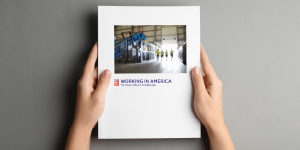The Stanford Digital Economy Lab is embarking on a far-reaching multimedia project that will explore how AI and other digital technologies are transforming the future of work in America—and how companies and workers can adapt and thrive.
Project goals

A media-rich web and digital presence will serve as the nexus of the project, with content pushed to social channels, including Twitter, LinkedIn, Instagram, YouTube, and Medium.

In-person and virtual events will bring researchers, industry experts, thought leaders, and the general public together to discuss and debate the future of work.

Podcast series will elevate the voices and experiences of workers on the front lines of change with themes based on geography, socioeconomics, or other connective thread.

A multi-episodic examination of how automation is changing work in America featuring stories of real people on the front lines of change.

A large-format publication will serve as a repository of stories and data—a time capsule documenting a key moment in the history of labor and automation in America.
Contact Christie Ko, executive director of the Stanford Digital Economy Lab, at christieko@stanford.edu.
Giving levels
| Number of donors needed | Amount |
|---|---|
| 1 @ | $1M |
| 3 @ | $250,000 |
| 5 @ | $50,000 |
Total funding needed: $2M
Timeframe: Aug 2021 – July 2023
The Stanford Digital Economy Lab is an integral part of the Stanford Institute for Human-Centered AI (HAI). We are the Institute’s primary hub for conducting research related to the economic implications of technology—a demonstration of HAI’s multidisciplinary approach to addressing complex problems. The Lab is co-sponsored by the Stanford Institute for Economic Policy Research.